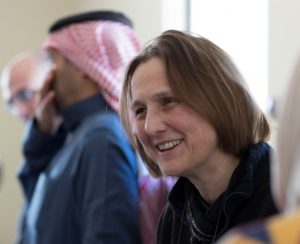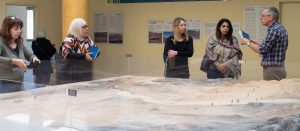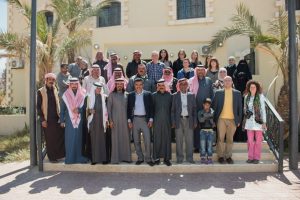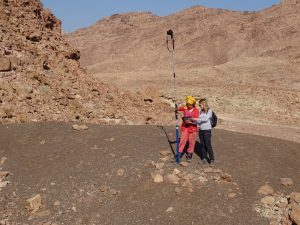Six different research strands have been organised within the interdisciplinary team to deliver the international project
'Our Past, Our Future all together in Faynan':
1: Representing the last 100 years of Faynan's history in the museum
Led by Dr Carol Palmer, CBRL and Dr Fatma Marii, University of Jordan.
The current exhibition in the museum ceases at the time of the Ottoman Empire, implying a disjunction between the past and the present. By ending so abruptly, the exhibition inadvertently implies that the ‘past is the past’, having played no role in shaping the present-day community, economy, politics and landscape. It also fails to record the character and diversity of lifestyles in Faynan throughout the last century, these now rapidly being lost from memory.

2: Local voices, telling their own history in their own way
Led by Dr Jessica Jacobs, Queen Mary College and Dr Fatima Al-Nammari, University of Petra

The current exhibition within the museum tells the story of Faynan from the first traces of human activity in the Palaeolithic, c. 500,000 years ago, to the Ottoman Empire, illustrating this by the archaeological sites within the Faynan landscape. The exhibition follows the development of hunter-gatherer communities through the Palaeolithic and Epi-Palaeolithic, and the emergence of the earliest farming communities. It then traces the development of metal working and increasingly complex societies through the Neolithic, Bronze and Iron Ages, the development of early states and annexation of Faynan by the Roman Empire in AD106. It continues the story of Faynan through the Byzantine period, and then into the Islamic and Ottoman periods. While this is informative, the museum does not currently provide any view of Faynan’s history from the local community’s perspective. What are their stories about the landscape? What do they think about the archaeological sites? How would they like the past represented? Building on their work elsewhere in Jordan, in Egypt and in the UK, Jessica Jacobs and Fatima Al-Nammari will run workshops with members of the community to learn about their view of history and develop means to represent this in the museum, potentially producing community history maps in fabrics using local materials.
3: Supporting Faynan schools and making the cultural heritage accessible to all
Led by Dr Arwa Badran, University of Durham and Dr Carol Palmer, CBRL

The museum exhibition has been designed for adult viewers, with a bias towards those with a relatively high degree of literacy. As such, it fails to attract and inform children and young adults. This is regrettable because, as shown by many educational studies, learning about the past can develop a range of skills in young people. With such a remarkable archaeological landscape in Faynan, the museum should serve to excite young people about the past, developing their enthusiasm to learn about the history of Faynan and Jordan, and even their aspirations to make their own contributions. Moreover, the long-term protection of archaeological sites in Faynan will depend upon future generations of adults having a greater awareness and interest in such sites than has been the case in the recent past. Working as an archaeological guide for visitors to Faynan can also be a source of income for young people. Following a series of initial meetings with six schools within the region, Arwa Badran and Carol Palmer will work with the teachers to develop a programme of activities, resources and facilities to enhance engagement between the Schools, the museum and the cultural heritage of Faynan.
4: Connecting the museum to the landscape
Led by Professor Steven Mithen and Elaine Jamieson, University of Reading
One of the purposes of the exhibition and accompanying guide-book was to direct visitors and members of the local community to sites in the landscape where there would be discretely placed information boards. Following some trial boards at Neolithic sites, this work-package will create an archaeological trail of information boards discretely placed at the key archaeological sites in the Faynan landscape to support eco-tourism and education, with accompanying maps at the museum.

5: Digitising Faynan’s cultural heritage with photogrammetry
Led by Professor Steven Mithen and Sarah Lambert-Gates, University of Reading and Dr Fatma Marii, University of Jordan

A further weakness of the museum is the absence of digital support. The cultural heritage of Faynan should be made accessible to those who are unable to visit Faynan itself, for use as an educational resource and for general interest. Even for those who are able to visit Faynan, many of its archaeological sites will remain inaccessible because of the challenges of the terrain. With techniques of digital photogrammetry, the archaeological sites of Faynan can be represented in a striking and informative manner, effectively enabling virtual visits to these locations. This will produce a series of 3D models of Faynan’s archaeological sites and artefacts to enhance their documentation and accessibility to the cultural heritage which has remote areas, with a large screen for viewing these in the Faynan Museum.
6: Enabling the museum to become a community hub by designing a ‘play/social space’
Led by Dr Gehan Selim, University of Leeds and Dr Fatima Al-Nammari, University of Petra
The further weakness of the current museum is the very fact that it is a ‘museum’: a building that traditionally houses relics of the past and is only visited for educational matters. While such a museum might be valuable for short-term visitors to Faynan, and be appropriate for relatively affluent local communities, they can only make a limited contribution to sustainable development in regions of economic deprivation. By the very nature of such museums, they present the past as separate from the present: the physical isolation of the building and the enclosure of objects and information within its walls, detach the past from the present and the everyday life of the local community. As such, museums of this type risk representing cultural heritage as belonging to others – in this case the Department of Antiquities and western-based archaeologists. This needs replacing: the concept and nature of the Faynan Museum needs modifying so that it presents the cultural heritage of Faynan as belonging to and benefiting the local community. Gehan and Fatima will lead a series of workshops with members of the local community to explore how the interior and exterior spaces of the museum can be developed to enhance its local value. Recommendations will be delivered to the Ministry of Tourism and Antiquities.
Following a series of workshops with the local community, this will develop a proposal for how the museum should be developed to provide a community hub. Recommendations will be delivered to the Ministry of Tourism and Antiquities.

